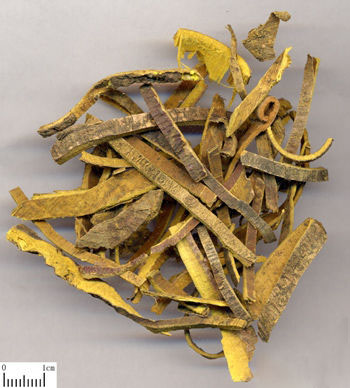Huang Bai
The Processing of Huang Bai
Origin
The bark of Phellodendron amurense Rupr or P. chinense Schneid. Rutaceae arbor plants with the skin off.
Location
The former one is called Guang Huang Bai, mainly growing in Liaoning, and Jilin provinces; the later one is called Chuan Huang Bai, mainly from Sichuan and Guizhou provinces of China.
Harvest
Cut part of the 10-year old bark from March to June.
The actual smell and taste
Slight smell, bitter taste.
Best quality
Thick bark, yellow cross section, sticky feeling when being chewed.
Processing
Unprocessed, or parched or prepared with salt.
The Effect of Huang Bai
Property
Bitter, cold; liver, gallbladder, large intestine, kidney and bladder meridians entered.
Actions
Clear heat and dry dampness, purge fire and remove toxicity, subdue deficiency heat.
Indications
A. Damp-heat syndromes such as jaundice, dysentery, stranguria, leucorrhea, eczema, damp sores
Although being the same bitter and cold as Huang Qin and Huang Lian, it has stronger actions of clearing heat and drying dampness than them. It is reinforced with Huang Qin and Huang Lian. Because it mainly goes to liver, gallbladder, large intestine, bladder to clear damp-heat in lower energizer, it is commonly used for eczema, sores due to damp and red, swollen and burning pain in feet and knees, atrophic lower extremities, itching vulva or swollen vulva due to damp-heat going down. It is often combined with heat-clearing, dampness-resolving, jaundice-relieving herbs for treating jaundice due to damp-heat. For instance, it is combined with Zhi Zi in Zhi Zi Bai Pi Tang from Shang Hai Lun. It is often combined with heat-clearing and dampness-drying, toxicity-removing and dysentery-checking herbs to treat jaundice due to damp-heat. For instance, it is combined with Huang Lian, Bai Tou Weng in Bai Tou Weng Tang from Shang Han Lun. It is often combined with stranguria-relieving diuretics to treat stranguria syndrome. For instance, it is combined with Che Qian Zi, Bi Xie, etc. , as in Bi Xie Fen Qing Yin from Yi Xue Xin Wu (Medicine Comprehended).It is often combined with spleen-invigorating and dampness-drying herbs to treat yellow fetid leukorrhagia, itching or swollen vulva and damp eczema and damp sores or red swollen and buring pain in the feet and knees or atrophic lower extremities. For instance, it is often combined with Cang Zhu to invigorate spleen and dry dampness, which is a basic formula for treating various damp-heat syndrome to strengthen the action of dispelling dampness, such as Er Miao San from Dan Xi Xin Fa. When being combined with herbs for soothing tendons such as Niu Xi and Yi Yi Ren, it will take a better action such as San Miao Wan from Yi Xue Zheng Zhuan (Orthodox Medical Record) and Si Miao Wan from Cheng Fang Bian Du (Explanation of Classic Prescription). It is often used externally for treating eczema, damp sores, leukorrhagia, itching vulva by making into powder or ointment and applying on the affected area or washing with the decoction.
B. Heat-toxin syndrome of abscesses and sores
The actions of its clearing heat and toxicity-removing are similar to that of Huang Qin and Huang Lian. It is mainly used for abscesses and sores of skin and five organs. Although using the single one can achieve good effects by taking orally or applying externally, it is better to combine with toxicity-removing and abscess-curing herbs such as Huang Lian, Yin Hua and Lian Qiao to strengthen actions. It works weaker than Huang Lian for abscess-curing and toxicity-removing, thus it is often combined with Huang Lian such as in the orally-taken Huang Lian Jie Du Tang and externally-applied Huang Lian Gao. It is often used for burns.
C. Syndrome of yin deficiency with effulgent fire
Being bitter and cold with the actions of clearing and descending, and entering kidney meridian for regarding deficiency heat and descending fire to strengthen yin, it is good for treating vexing heat in chest, palms and soles, tidal fever and night sweats, and seminal emission. It is reinforced with Zhi Mu to relieve deficiency fever, descend fire to strengthen yin because it doesn't has the actions of Zhi Mu in aspect of moistening and tonifying yin. The syndrome of yin deficiency with effulgent fire refers to the deficiency of kidney congenital yin. It is necessary to combine with yin-tonifying herbs to treat the fundamental aspect. For instance, it is combined with Shu Di Huang, Gui Ban, etc. , as in Da Bu Yin Wan from Dan Xi Xin Fa. In addition, it can be used for various zang-fu organ excess heat syndrome to clear excess fire of liver, gallbladder, and stomach for its actions for clearing heat and purging fire. For instance, this single herb is used to treat red, swollen and painful eyes due to liver heat in Wu Xing Tang from Yan Ke Long Mu Lun (Treatise on Dragon-Wood in OPhthalmology) and it is used to treat diabetes due to stomach heat in Du Xing Fang (Prescription with One Herb); In Qian Jin Fang, it is used singly to treat mouth sores due to stomach heat.
Dosage and Administrations
Decoct 6~10 g. Proper dose is for external application. The raw one has strong actions of clearing heat and drying dampness, removing toxicity and purging fire. It is good for damp-heat, heat-toxicity, and zang-fu excess heat syndrome. The salty preparation can weak its bitterness and dryness and make it easily enter kidney meridian. So the salty prepared one is commonly used for syndrome of yin deficiency with effulgent fire.
Cautions
It is contraindicated for deficiency-cold syndrome. Overdosage and long-time taking will impair spleen and stomach.
Notes for Huang Bai
Naming
Huang Bo (Cortex Phellodendri)——Shen Nong Ben Cao Jing (Shen Nong’s Herbal)
